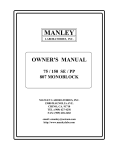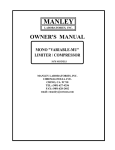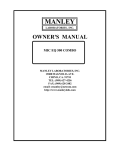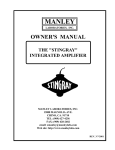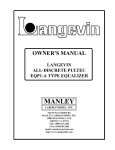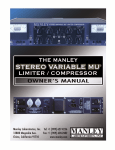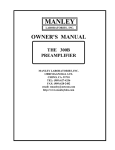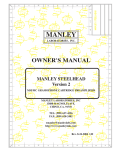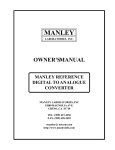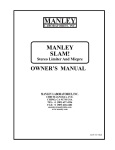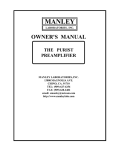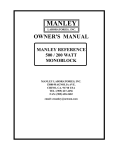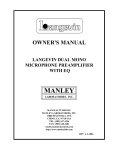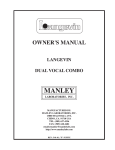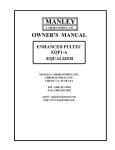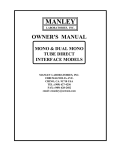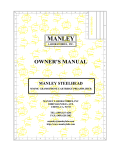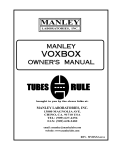Download Manley Langevin 20 BIT DIGITAL TO ANALOG CONVERTER Owner`s manual
Transcript
OWNER'S MANUAL LANGEVIN ELECTRO-OPTICAL LIMITER MANLEY LABORATORIES, INC. MANLEY LABORATORIES, INC. 13880 MAGNOLIA AVE. CHINO, CA. 91710 TEL: (909) 627-4256 FAX: (909) 628-2482 email: emanley @ netcom.com http://www.manleylabs.com CONTENTS SECTION PAGE INTRODUCTION 3 MAINS CONNECTIONS 4 OPERATION NOTES 5&6 FRONT PANEL 7 REAR PANEL 8 TROUBLE SHOOTING 9 & 10 INTERNAL ADJUSTMENTS 11 SPECIFICATIONS 12 WARRANTY 13 WARRANTY REGISTRATION 14 INTRODUCTION THANK YOU!... for choosing the Langevin Stereo Electro-Optical Limiter. This Limiter follows in the tradition of the vintage LA-3A Leveling Amplifier using a passive electro-optical device to control gain. The advantage of a passive device is that it eliminates the need to push the music through many transistors and / or ICs as would be the case in a VCA based Limiter. Also like the LA-3A, the Langevin utilizes a minimalist discrete transistor line amplifier for make-up gain. This is one of our favorite clean and powerful line drivers. Other owners of this unit love the way they can drastically (10 dB) limit without introducing unmusical harshness. An important feature is that it is quick and easy to use. Also rare is that it limits in a way that engineers expect when they patch in a limiter. For critical vocal tracks - this is the one to demand. Unlike the LA-3A, we use LEDs to illuminate the photo-resistor rather than electroluminescent elements which are often slow and unreliable. We also use a solid state side-chain to drive the LEDs. The Limiter also features a BYPASS switch that retains the tube section at unity gain as well as an innovative BALANCE control to "fine tune" the stereo image in LINK mode. Around Manley Labs we call the unit "The Langevin ELOP". Please take a few moments to read through this manual carefully as it contains information essential to proper operation of this unit. Thank you again, and please enjoy GENERAL NOTES LOCATION & VENTILATION The Langevin Electro-Optical Leveling Amplifier must be installed in a stable location with ample ventilation. It is recommended, if this unit is rack mounted, that you allow enough clearance on the top and bottom of the unit such that a constant flow of air can move through the ventilation holes. WATER & MOISTURE As with any electrical equipment, this equipment should not be used near water or moisture. SERVICING The user should not attempt to service this unit beyond that described in the owner's manual. Refer all servicing to Manley Laboratories. WARNING! ! TO PREVENT THE RISK OF ELECTRIC SHOCK DO NOT OPEN THE CABINET REFER SERVICING TO QUALIFIED PERSONEL 3 MAINS CONNECTIONS Your Limiter has been factory set to the correct mains voltage for your country. The voltage setting is marked on the serial badge, located on the rear panel. Check that this complies with your local supply. Export units for certain markets have a moulded mains plug fitted to comply with local requirements. If your unit does not have a plug fitted the coloured wires should be connected to the appropriate plug terminals in accordance with the following code. GREEN/YELLOW BLUE BROWN EARTH NEUTRAL LIVE terminal terminal terminal As the colours of the wires in the mains lead may not correspond with the coloured marking identifying the terminals in your plug proceed as follows; The wire which is coloured GREEN/YELLOW must be connected to the terminal in the plug which is marked by the letter E or by the safety earth symbol or coloured GREEN or GREEN and YELLOW. The wire which is coloured BLUE must be connected to the terminal in the plug which is marked by the letter N or coloured BLACK. The wire which is coloured BROWN must be connected to the terminal in the plug which is marked by the letter L or coloured RED. DO NOT CONNECT/SWITCH ON THE MAINS SUPPLY UNTIL ALL OTHER CONNECTIONS HAVE BEEN MADE. Note: This unit has been factory wired for your country. If you plan to take the unit to countries with a different mains voltage you will need to send the Limiter to Manley Labs for the correct power transformer - or use AC voltage converters. 4 OPERATION NOTES The Langevin Electo-Optical Limiter follows certain traits and traditions established by the UREI LA-3A and similar levelling amplifiers. These traits can be divided into two aspects - electronic and operation. The electronic concept is simple and rather clean. Use the audio to light up LEDs which shine onto photo-resistors. These photo-resistors in combination with a fixed resistor simply act as a voltage divider to attenuate the signal. The line amplifier only functions to provide extra gain to make up for attenuation losses and then act as a fine cable driver. Simple, elegant and minimal. Operation aspects are also simple, elegant and minimal. There are usually only a "threshold" and "gain" control. Most have no user adjustment of "attack", "release", "ratio" or functions for de-essing or external sidechains. The user is "stuck" with fixed time constants and a feature list that seems anemic compared to dynamic processors costing far less. So why are "LA" style opto based limiters so popular ? Several reasons. To paraphrase Letterman "The number one reason why "LA" style limiters are favorites is because.... they work right on vocals". This "rightness" has a few aspects. The first is that "LA" style limiters don't leave much trace of limiting as they work. This is partly due to tubes, partly to the simplicity of the opto circuit and partly because the user can't alter the attack and release. Almost every VCA based design seems to leave electronic personality on that critical vocal track. This is usually undesirable. Our Opto circuits has no active limiting in the signal path. Tube circuits have the potential to be musically more transparent than transistors because tubes are generally more linear devices. However, there are many poor examples of tube circuits in use, and many ways to butcher the quality. We chose to use our Langevin line amplifier circuit which we also use in the Langevin Enhanced Pultec Equalizers (rather than copy UREI designs) because frankly our circuit sounds better and cleaner. Back to this matter with fixed time constants. We get requests to modify our "ELOP" for more controls but we get even more people raving about how great and useful the "ELOP" is now. The attack, release, knee and ratio (curve) are a function of the Vactrol Cell we chose to use. The choice was based on the attack and release characteristics. Changing the time values in this circuit involves different choices of Vactrols. Not practical. Not in a "LA" style limiter. There is a major advantage to fewer controls. You simply adjust the Threshold for the desired limiting amount and adjust the Gain for the desired level to tape - then record. The limiter does what its supposed to do - nothing more - nothing less. Kinda like automatically right, strangely quick and easy, and pretty much non-distracting. We use the phrase "Set it and forget it". This is a very important feature that would be lost with a variety of controls. A good engineer wants to be ready to record "now" and does not want to be fussing with controls while a lead vocal is going to tape. Unfortunately most compressors drag the engineer's attention away (and often the singer's and producer's attention away as well). The time and slope characteristics of Opto elements are not easy to describe and probably even more difficult to simulate. The attack is fast, not super fast "brick wall", but fast enough to "catch" consonants. It is also a function of level. At lower reduction levels and lower peaks the Vactrol is slower. It becomes faster with sharp peaks and heavier levels of reduction. Release is similar but 10 to 20 times slower. Quick peaks are handled with quick release and as gain reduction nears zero the Vactrol gets slower like gentle braking to a stop. It is possible to"trick out" an opto circuit for conventional operation but generally the results have been not well liked. 5 The slope or ratio is also difficult to simulate. The initial ratio is low and becomes higher with more gain reduction until the leds light up fully and further reduction is not easy. This upper limit of reduction is in the area of 20 dB or at the bottom of the GR meter where the ratio becomes low again but this would be a severe setting that few engineers could use. Distortion becomes audible at very deep limiting. In a tech shop, it is easy to drive the limiter to 20 dB of reduction and beyond where the GR meter shows a flaw in that it "folds back". We put a higher priority on having the meter show what the Opto was doing accurately with "normal settings" than extreme test bench observations. Test benches don't make hit records. So the Opto Limiters seem to be great for vocals, what else are they used for and what about sounds where the time constants are less than optimum ? Historically "LA" style limiters are often used for bass and guitar tracks. They can be ideal for brass, saxes, synths and similar sounds with superb results. There are other compressors that work well for these instruments but few that are as transparent. Usually, when you hear of an engineer using a non-Opto compressor for these instruments it is usually framed with "for the crunch" or because they add some desired color. There is only a very small number of "clean" general purpose variable time compressors which seem to give Opto units competition - our Variable MU is at the top of that list. Where the "LA" style limiters are not always appropriate is for percussion and for mixes where the percussion is just right. The Opto typically reacts fast to peaks - fast enough to remove drums from a mix but not quite fast enough to be called "brick wall". Individual drums tend to have a little of the initial transient let through but the desirable tone of the drum is diminished. If used gently, this can be applied to brighten up the attack of the drum, but it is difficult to apply in practice because drums can be very dynamic. One great use is on the room mics. The initial drum sound is pulled down, then the natural reverb is increased. Shades of early Led Zep. While we mentioned that "LA" style limiters are not what we suggest for mixes, there are times when the drums are too loud or when the engineer can mix "into" the limiter. Both techniques are possible but not necessarily easy. One trick is very little movement on the GR meter. Some of our clients use the Opto on mixes as an effect. This application is valid as long as the effect given and the effect desired are the same. There is not many options for adjustment and fine tuning. The good news is that at least the Manley is clean enough to pass a good mix. In a live sound setting the Opto will perform as a fine speaker protection device. Once again the Threshold is set for minimal limiting with music and is just adjusted to encourage the pyrotechnician to try harder tomorow to damage your system. The Balance Control deserves some description. Often, with stereo tracks, once you apply limiting the apparent left/right balance shifts a little - even in link. While the Link switch makes both channels equal in gain reduction, the change may still happen. The clues we use to establish position include volume, transients and ambience as well as delay and tone differences. Limiting involves changes with the first three. We included a simple adjustment to assist slight trimming to restore the desired image center. Turning the Balance control Left increases the Left input up 1 dB and decreases the Right input by 4 dB and turning the Balance to the Right raises the right and lowers the left. Use both Thresholds while using Link mode to create the desired reduction. It may be easiest to "get in the ballpark" in normal mode. A slight change in Threshold and Output is expected when you switch to Link. 6 FRONT PANEL F G A B C D E E D C B A H NOTE: Right channel is a mirror image of the Left We do this to preserve exact similarity of the audio electronics (path length, PCB layout, etc) A IN / BYPASS. Audio still flows through the tubes in BYPASS but at Unity Gain. Switching to IN provides the Limiting controls and functions. Use this switch to verify that the limiting is not messing up the original sound but enhancing it or at least levelling the volume. B REDUCTION. Adjusts the amound of limitng in the that channel. This could also be called Threshold. Turning this clockwise introduces limiting. C GAIN Adjusts the gain of that audio channel. Unity gain is about the seventh marking or 1 o'clock. Limiting usually requires some additional "make-up" Gain to compare IN / BYPASS. The Gain control can also be used as the level to tape. D METER SELECT Switch to REDUCTION to see the amount of limiting in dB. The wider and quicker the reduction meter swings the more likely the limiting will be audible. Switch to OUTPUT to show the output level as a conventional VU meter. E METER Shows the amound of gain reduction in dB from the 0 dB mark. Functions as a high quality VU meter when the switch is set to METER OUTPUT. Note that VU meters and PEAK meters rarely agree and that digital recorders use peak meters - Rely on those for clean recording. VU meters are standard with analog machines and big consoles because they correspond well with perceived loudness. F STEREO LINK / NORMAL Switching the toggle UP provides the STEREO LINK. It is used on stereo tracks so that when either channel is called to limit, both channels reduce the same amount at the same time. This prevents image shifts and an instrument should stay where you panned them. Limiting individual sounds is usually done with the switch down where each side is independent of the other. G STEREO ADJUST Active only in LINK mode. It offers a quick and easy control to adjust the LEFT / RIGHT BALANCE by few dB. One side increases by 1 dB while the other side drops by 4 dB. It operates on the input signal before everything. H POWER SWITCH Switch up to turn the unit ON. 7 REAR PANEL A B D C F E K J I G A 1/4" INPUT (BALANCED) (RIGHT) B XLR INPUT (BALANCED) (RIGHT) C 1/4" OUTPUT (UNBALANCED) (RIGHT) D XLR OUTPUT (BALANCED) (RIGHT) E IEC MAINS CONNECTOR Standard IEC mains connector for 50 /60 Hz AC. F MAINS FUSE Replace with only a 1 Amp slo-Blo fuse. G XLR INPUT (BALANCED ) (LEFT) PIN 1: GROUND PIN 2: HOT (+) PIN 3: GROUND H 1/4"INPUT (BALANCED ) (LEFT) TIP: HOT SLEEVE: GROUND I XLR OUTPUT (BALANCED) (RIGHT) PIN 1: GROUND PIN 2: HOT (+) PIN 3: GROUND J 1/4" INPUT (UNBALANCED) (RIGHT) K GROUND TERMINALS H TIP: HOT SLEEVE: GROUND Any of the "balanced inputs can be used with unbalanced sources PIN 1: GROUND PIN 2: HOT (+) PIN 3: GROUND TIP: HOT SLEEVE: GROUND Use only 1/4" MONO (tip - sleeve) plugs with these jacks otherwise levels will be low. PIN 1: GROUND PIN 2: HOT (+) PIN 3: GROUND TIP: HOT SLEEVE: GROUND Use only 1/4" MONO (tip - sleeve) plugs with these jacks otherwise levels will be low BLACK = CIRCUIT GROUND or "Audio Ground" GREEN = CHASSIS GROUND or "Electrical Ground" ie mains pin 3 Generally these two ground terminals are connected together with the included "ground strap" (a small flat piece of metal) but they can be individually used for different grounding systems. Another use for these is in troubleshhoting HUM problems. Experiment with attaching a wire from the console to only the BLACK terminal or connecting the GREEN to a rack, (etc). 8 TROUBLE-SHOOTING There are a number of possible symptoms of something not quite right, some may be interfacing, others we will touch on as well. The preceding page shows that all the inputs and outputs of the Electro-Optical Limiter are unbalanced. No need to panic. We have sold hundreds of these units and less than 1% ever had a problem with hum or interfacing to balanced consoles or other gear. However if you suspect a problem the following paragraphs should help. NO POWER, NO INDICATORS, NADA - Probably something to do with AC power. Is it plugged in? Check the fuse on the back panel. A blown fuse often looks blackened inside or the little wire inside looks broken. A very blackened fuse is a big hint that a short occured. Try replacing the fuse with a good one of the same value and size. If it blows too then prepare to send the unit back to the dealer or factory for repair. The fuse is a protection device and it should blow if there is a problem. If the unit works with a new fuse, fine. Check the MAINS VOLTAGE SELECTOR if one is fitted. Some of our models are able to have them and some don't. It should be set correctly for your mains voltage. LIGHTS BUT NO SOUND - First try plugging the in and out cables into some other piece of gear to verify that your wires are OK. Assuming that it was OK into the other unit it probably is still a wiring thing. The AES standard calls PIN 2 HOT on XLRs but there is still lots of gear out there with PIN 3 HOT. When two units are connected and both are unbalanced but don't seem to agree which pin is hot - the signal is shorted out. If it is not lost entirely, it will be almost gone and extremely distorted. THE CURE - a phase reversing adapter that swaps pin 2 and pin 3 on one XLR - or get out a soldering iron and swap wires yourself. All Manley gear after 1995 is pin 2 hot. Some Manley gear has balanced and floating outputs and some has unbalanced transformerless outputs. This unit has two discrete line drivers - one driven from the other. If the XLR pin 2 is shorted to ground or pin 3 there will be no signal from the XLR. If pin 3 is shorted to ground - a typical way to drive unbalanced inputs - then the output on pin 2 will be 6 dB low. The best way to drive unbalanced inputs is with the unbalanced outputs. LEVELS SEEM TO BE WRONG, NO BOTTOM - Several possible scenarios. The above paragraph describes the output line drivers. If you are using the balanced XLR outputs and feeding an unbalanced input (it happens) you will only be getting 1/2 the signal which means that you lost 6 dB. There is a "trick" if you just want to use the XLRs but from time to time feed unbalanced inputs. Insert a 1/4" mono (tip - sleeve) plug (unwired) into the unbalanced output. This makes the levels right. You could leave this plug in permanently but we don't recommend it because you can have 6 dB more headroom into balanced inputs if it is removed. More headroom is one of the biggest factors of great sounding gear. Manley uses the professional standard of +4 dBm = Zero VU = 1.23 volts AC RMS. A lot of semi-pro gear uses the hi-fi reference of -10 dBm = Zero VU. This is a 14 dB difference that will certainly look goofy and may tend to distort. Often there are switches on the semi-pro gear to choose the pro reference level. We do not provide that kind of switch because of inevitable compromises in the signal path. If the loss looks close to 6 dB and it sounds thin then one half of the signal is lost. The cause is probably wiring again. One of the two signal carrying wires (the third is ground / shield on pin 1) is not happening. Check the cables carefully because occasionally a cable gets modified to work with a certain unit and it seems to work but its wrong in other situations. If only one side of the Limiter exhibits this problem, it may be a problem in the Limiter. See the next item. If you have almost no signal and what you can hear is distorted then you probably have pin 2 shorted to ground or to pin 3. This might happen if the cable is mis-wired and/or you are feeding an unbalanced input. USING THE 1/4" JACKS BUT THE LEVEL IS LOW - The 1/4" output jacks on this unit are unbalanced and require a mono plug (tip - sleeve plug) and not a stereo plug (tip - ring - sleeve plug. The Limiter uses the ring to set the output level for this output. When the ring is shorted to the sleeve the output becomes 6 dB louder. This is needed because the XLR has differential outputs which together give that extra 6 dB. Using the ring compensates for this difference and both outputs will be the same level (+4 dBv). Other manufactures often use a common circuit that does this in a different automatic way. The generic name is "transformer like" but unlike transformers, these outputs can be unstable (oscillates) into some cables and often have low headroom into unbalanced inputs. Our method works better as long as one uses a mono phone plug. We have included an appendix: WIRING YOUR OWN CABLES that may help. For reference both the XLR and 1/4" inputs are balanced electronically and not with a transformer. The inputs will work fine and should reject hum from either balanced or unbalanced outputs. 9 HUM - Let's assume it knows the words. Once again - several possibilities - several cures. Most likely it is a ground loop. The two most common procedures are: try a 3 pin to 2 pin AC adapter (about a dollar at the hardware store) which is better than messing up the power cable by bending the ground pin until it breaks off. Method two - cutting the shield on one side of the cable. This is usually done at every female XLR to "break" all loops. You may get a loop simply from the rack. All the other gear in the rack is "dumping" ground noise onto the rack rails. Try removing the Limiter from the rack so that it is not touching any metal. You may have cured a non-loop hum. Some gear radiates a magnetic field and some gear (especially if it has transformers) might receive that hum. A little distance was all it took. This unit has GROUND terminals on the back panel. Normally these terminals are simply connected together with a "ground strap" (a small flat piece of metal that can become lost). First check that the strap is connecting the two ground terminals. If missing try a short piece of wire to connect these terminals. Not that - try separating them, try connecting a wire from the rack to the each terminal, try connecting a wire from the console to the terminals (one at a time). These terminals are meant to help with a variety of different studio "grounding schemes". Experiment - you will come up with the best way for your situation. A cool method of reducing all sorts of hum and noise is to use the new 60-0-60 balanced AC power transformers available from Equi=Tech and Furman. It costs more but works best. Hum might be because of the unbalanced input but this hints at ground loops and questionable wiring. THE METERS ARE OUT OF CALIBRATION - If the problem only seems to be when the unit is just turned on it's normal. It should warm up. It might be a half dB out for 15 minutes - relax. If they drift a tenth of a dB over the course of a day it is because of bad AC power fluxuations - chances are other gear is doing worse, you just haven't found out yet. Your unit will have been factory calibrated and tested twice before you received it. Sometimes parts drift a bit in value over the years, or you have repaced tubes and want the unit calibrated at the same time, or you just want it as perfect as it can be. These are good reasons to turn the page and go through the calibration procedure or sent it to a technician or the factory for a tweak. If you send the unit to a tech, you should include this manual because they will need it. If you do it yourself, you will need an Oscillator and a few screwdrivers and it would be nice to have a VOM meter and Scope but not necessary. Once in a while we get a call from a client with a "digital studio" with confusion about levels. They usually start out by using the digital oscillator from their workstation and finding pegged VU meters the first place they look and they know it can't be the workstation. Even a -6 level from their system pegs the meters. Some of you know already what 's going on. That -6 level is referenced to "digital full scale" and the computer might have 18 or 18.5 or 20 dB of headroom built in. That -6 level on the oscillator is actually a real world analog +12 or +14 and those VU meters don't really go much further than +3. There are a few standards and plenty of exceptions. One standard is that pro music (non-broadcast) VU meters are calibrated for 0VU = +4 dBm =1.228 volts into 600 ohms. Another standard is that CDs have a zero analog reference that is -14 dB from digital full scale or maximum. This allows sufficient peak headroom for mixed material but would be a bad standard for individual tracks because they would likely distort frequently. This is why digital workstations use higher references like 18 and 20 to allow for peaks on individual sounds. It may be too much in some cases and too little in others. Add two other sources of confusion. Peak meters and VU meters will almost never agree - they are not supposed to. A peak meter is intended to show the maximum level that can be recorded to a given medium. VU meters were designed to show how loud we will likely hear a sound and help set record levels to analog tape. By help, I mean that they can be only used as a guide combined with experience. They are kinda slow. Bright percussion may want to be recorded at - 10 on a VU for analog tape to be clean but a digital recording using a good peak meter should make the meter read as high as possible without an "over". Here is the second confusion: There aren't many good peak meters. Almost all DATs have poor peak meters that do not agree with each other. One cannot trust them to truly indicate peaks or overs. Outboard digital peak meters (with switchable peak hold) that indicate overs as 3 (or 4)consecutive samples at either Full Scale Digital (FSD) are the best. They won't agree with VU meters or Average meters or BBC Peak meters either. Each is a different animal for different uses. The Limiter should help digital and analog achieve consistent levels but use each meter for it's own strength. The Reduction mode is useful with everything. We hear the phrase "brick wall limiter" bantered about these days. Theoretically this kind of limiter would be ideal just before an analog to digital converter or broadcast transmitter. Unfortunately, we don't know of one that sounds OK for most mixes or general purpose applications. This limiter is better than most for this application but it is not a perfect ultra-fast brick wall. It is fast enough to significantly reduce transients in a mix (kills drums) and has a steep ratio (better than 10:1) after a few dB of limiting (soft knee). It will allow for several dB louder mixes and/or no percievable A to D distortion. If used for this purpose, we suggest that one only uses a few dB of gain reduction or else your mix may change. The alternative is to "mix into the limiter" so that mix decisions are based on hearing how the limiter is reacting. This can be a little dangerous with material that has changes in dynamics. It works best with automated mixes and awareness that drums may be a moving target. 10 INTERNAL ADJUSTMENTS 1 5 4 8 2 1) 9 6 7 10 3 +36 Volt DC adjust with meter from ground to resistor marked by arrow. Check this first and adjust if needed. It is the power supply regulator adjustment. Now for the audio .... You will have to start out by setting front panel controls to these settings. BYPASS mode, SEP ( LINK OFF ), REDUCTION controls counter clockwise (MIN), GAIN to 1:00 or unity, Balance at 12:00. The top will need to be open. There are two screws on the top that hold the top perforated panel to the back. Remove these and the perforated top will slide back. Be careful! THERE ARE HIGH VOLTAGES INSIDE THE LIMITER. DO NOT HOLD THE METAL PART OF THE SCREWDRIVER. DO NOT PROBE AROUND WITH THE SCREWDRIVER OR FINGERS. The unit should be on for about 15 minutes to allow for "warming up". 2 & 3) This adjusts theamplifier gain in all modes. 1 KHz sine at 1.23 volts RMS (+4 dBm, 0 VU) to both inputs. BYPASS mode. Adjust 2 & 3 for unity gain at outputs. 4 & 5) This adjusts VU meter calibration for OUTPUT. Same input, Meter switches to OUTPUT. Adjust for 0 VU on the Meters. 6 & 7) This adjusts the meter zero for Reduction mode. Meter switches to REDUCTION. Adjust for 0 VU on the Meters. 8 & 9) This adjusts the meter in Reduction mode to reflect the actual gain reduction accurately. You will probably need to increase the oscillator 10 dB to get Limiting. Switch from BYPASS to IN. Meter switches to OUTPUT. Adjust GAIN controls to get 0 VU on the METERS again, then adjust REDUCTION controls to reduce the signal to -4dB. Switch METERS to REDUCTION. Adjust 8 & 9 to get -4 dB on the METERS. 10) This adjusts the gain of the right side chain and adjusts the side chain balance in Link. Switch the LINK ON. There should be 1 to 2 dB change in the Meters. Adjust 10 so that the meter is the same for both sides. You may have to re-adjust 8 and 9. Check that both in LINK and SEPARATE that both channels show the same reduction. This is a final check to verify that all adjustments are OK and the unit is ready for use. Confirm that 0 VU on the meters is +4 dBm with an external VU meter or VOM that reads between 1.22 and 1.23 volts AC and that gain reduction reads the same on OUTPUT and REDUCTION and that LINK or UN-LINK does not reduce the gain unevenly on the two sides. Remove the power and slide the top in all the way where it will fit into a groove in the front panel and put those two top screws back in. Done ! SPECIFICATIONS Langevin Electro- Optical Limiter Maximum Input (Bypass through Line Amplifier) +30 dBv (with Limit "IN" the maximum is entirely variable) Maximum Output +30 dBv Headroom (referenced to +4 dBv) 26 dB Frequency Response: 10 Hz to 70 kHz +/- 0.5 dB THD & Noise (1kHz @ +4 dBm) .015% Noise Floor (Gain set to minimum) -80 dB Wideband Signal to Noise 126 dB typical Maximum Gain 15 dB Maximum Limiting 22 dB Maximum Limiting with +4 dBm sine 15 dB Attack Time 50 mS Release Time 1.5 Seconds Power Consumption .35 Amps @ 115 VAC Fuse 1 Amp Slo-Blo Size (1U) 19" x 1.75" x 10" Actual Weight 9 Lbs Shipping Weight 10 Lbs 12 WARRANTY All Manley Laboratories equipment is covered by a limited warranty against defects in materials and workmanship for a period of 90 days from date of purchase to the original purchaser only. A further optional limited 5 year warranty is available to the original purchaser upon proper registration of ownership within 30 days of date of first purchase. Proper registration is made by filling out and returning to the factory the warranty card attached to this general warranty statement, along with a copy of the original sales receipt as proof of the original date of purchase. Only 1 card is issued with each unit, and the serial number is already recorded on it. If the warranty registration card has already been removed then this is not a new unit, and is therefore not warranted by the factory. If you believe this to be a new unit then please contact the factory with the details of purchase. This warranty is provided by the dealer where the unit was purchased, and by Manley Laboratories, Inc. Under the terms of the warranty defective parts will be repaired or replaced without charge, excepting the cost of tubes. No warranty is offered on tubes, unless: 1. a Manley Laboratories preamplifier is used with a Manley Laboratories amplifier, and 2. the warranty registration card is filled out. In such a case a 6 month warranty on tubes is available with the correct recording of the serial number of the preamplifier on your warranty registration card. If a Manley Laboratories product fails to meet the above warranty, then the purchaser's sole remedy shall be to return the product to Manley Laboratories, where the defect will be repaired without charge for parts and labour. The product will then be returned via prepaid, insured freight, method and carrier to be determined solely by Manley Laboratories. All returns to the factory must be in the original packing, (new packing will be supplied for no charge if needed), accompanied by a written description of the defect, and must be shipped to Manley Laboratories via insured freight at the customer's own expense. Charges for unauthorized service and transportation costs are not reimbursable under this warranty, and all warrantees, express or implied, become null and void where the product has been damaged by misuse, accident, neglect, modification, tampering or unauthorized alteration by anyone other than Manley Laboratories. The warrantor assumes no liability for property damage or any other incidental or consequental damage whatsoever which may result from failure of this product. Any and all warrantees of merchantability and fitness implied by law are limited to the duration of the expressed warranty. All warrantees apply only to Manley Laboratories products purchased and used in the USA. Some states do not allow limitations on how long an implied warranty lasts, so the above limitations may not apply to you. Some states do not allow the exclusion or limitation of incidental or consequential damges, so the above exclusion may not apply to you. This warranty gives you specific legal rights and you may also have other rights which vary from state to state. WARRANTY REGISTRATION We ask that you please fill out this registration form and send the bottom half to: MANLEY LABORATORIES REGISTRATION DEPARTMENT 13880 MAGNOLIA AVE. CHINO CA, 91710 Registration entitles you to product support, full warranty benefits, and notice of product enhancements and upgrades. You MUST complete and return the following to validate your warranty and registration. Thank you again for choosing to use Manley Laboratories. MODEL ____________________ SERIAL No. ______________________ PURCHASE DATE ______________ SUPPLIER ______________________ -----------------------------------------------------------------------------------------------------PLEASE DETACH THIS PORTION AND SEND TO MANLEY LABORATORIES MODEL LANGEVIN ELECTRO-OPTICAL LIMITER SERIAL No._____________________________ PURCHASE DATE ______________ SUPPLIER _______________________ NAME OF OWNER _______________________________________________ ADDRESS ______________________________________________________ CITY, STATE, ZIP ________________________________________________ TELEPHONE NUMBER ___________________________________________ Serial #'s of Associated Manley Laboratories Equipment ___________________ ________________________________________________________________














